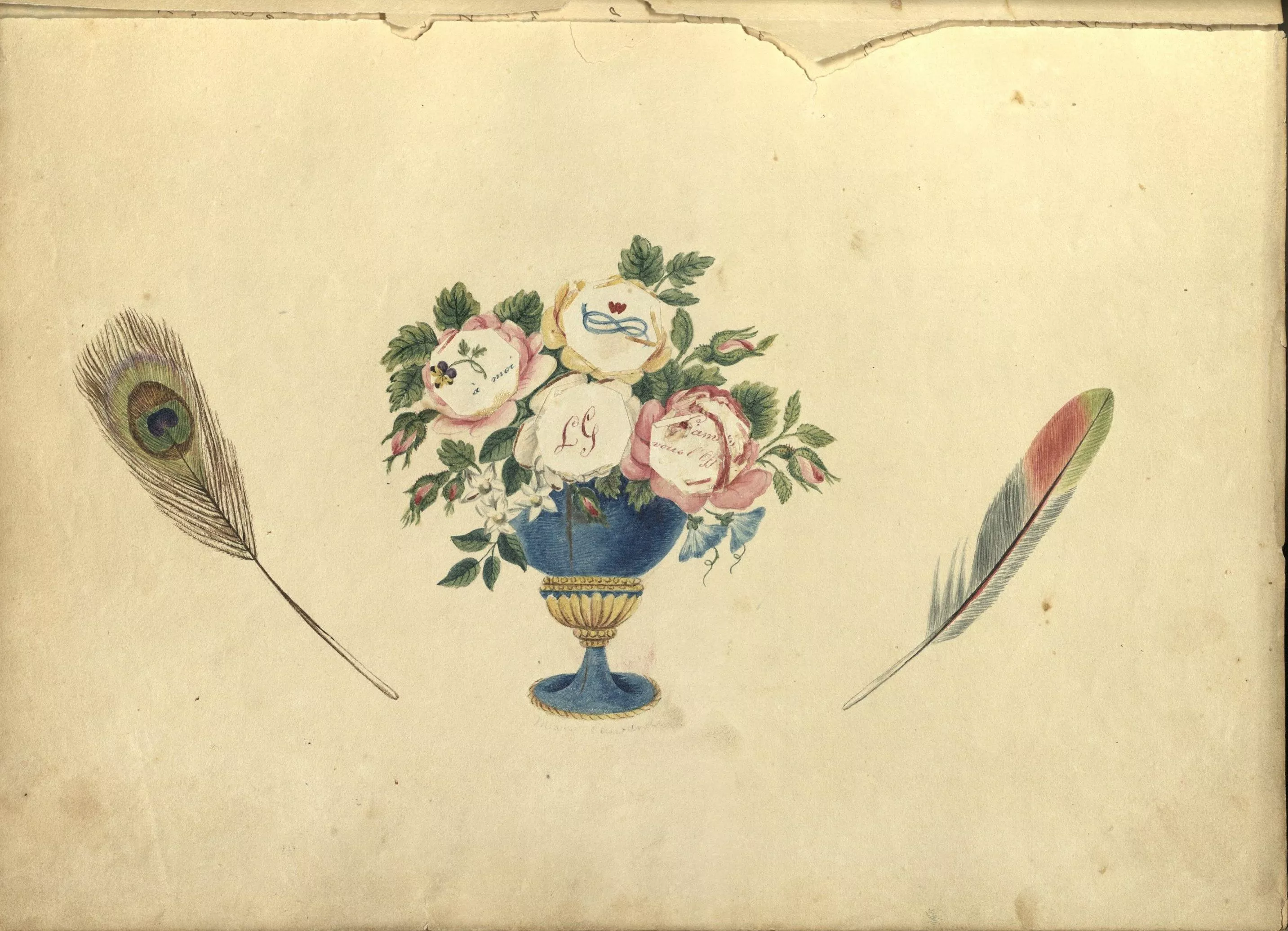Creation Date
1822-1823
Height
25 cm
Medium
Genre
Description
This page of watercolor painting and cut paper work is found in an album compiled around 1822 and 1823 in honor of a certain Miss [Louisa?] Gilman. At the page’s center is a footed vase, classical in style, which holds an arrangement of orange blossom, morning glory, and roses, the latter both budding and in full bloom. The vase is framed by two feathers. Someone has cut the center out of each of the vase’s four fully blooming roses, revealing four small pieces of paper, which have been drawn on in watercolor and ink and pasted to the underside of the page, thereby lending it dimensionality and depth. One of these pieces, revealed from out of the center of the white rose, has been inscribed with the initials L.G. A second piece, positioned under a cut-out yellow rose, holds a drawing of a kind of lovers’ knot and two interlocking hearts. At the center of the pink rose on the left, a drawing of a pansy accompanies the phrase “à moi," thereby yielding a rebus that, in a mixture of the French language with the language of flowers, punningly instructs the beholder “Pensez à moi” (Think of me). French reappears inside the flower on the right. The label, partially obscured, almost certainly reads “L’amitié vous l’Offre” (Friendship offers it to you). The latter label declares the motivation that underlies and pulls together the multiple components of this page: these emblems of sentimental friendship have been gathered up as an offering to Miss Gilman and a memorial of the artist’s affection. Two hundred years later, the identity of the present-giver who created the page seems impossible to retrieve; the penciled signature at the bottom of the page has been almost completely erased, though it may read “Mary Edwards.”
Some of the other gifts of friendship deposited in the pages of this album are poetic: for instance, verses titled “For the Album” and verses addressed “To Miss Gilman, after having seen a withered flower upon her bosom.” One member of Miss Gilman’s circle gave her music: the score and lyrics for a song titled “Composed for Miss Gilman’s Album” occupy four pages in her book. The inclusion early in the album of the Unitarian minister Samuel Gilman’s long poem celebrating the achievements of modern science, “The History of a Ray of Light” (later published in the literary annual The Atlantic Souvenir), makes it feasible that the Miss Gilman whose name recurs throughout the later pages is very probably Louisa Gilman, the Reverend Gilman’s younger sister. In 1819 her brother and his wife, the writer Caroline Howard Gilman, had relocated from Boston to South Carolina, when the Reverend Gilman took up the pulpit at Charleston’s new Unitarian church. One might conjecture that Louisa Gilman, then aged 24 or 25, not yet married, paid the family a visit in 1822, and that the contributions to her album made by her Charleston acquaintance were intended—as the verses of farewell and verses about remembrance of absent friends the album collects make explicit—to supply her with so many memorials of that visit.
The majority of the papery souvenirs and goodbye presents that are arrayed inside Miss Gilman’s album are works of visual art. These are almost uniformly flowery (many pages are festooned around the margins with pictures of blossoms), an indication of how central the practice of flower-painting was to prevailing definitions of female accomplishments. “There are few accomplishments more graceful, more innocent in their tendency, and more pleasing,” wrote James Andrews prefacing his Lessons in Flower Painting, in a Series of Easy and Progressive Studies (1836): Miss Gilman and her friends would have represented the target audience for how-to books such as Andrews’s. Feminist scholars have pointed out, however, that during the early nineteenth century study of flower painting might well have represented for its young female practitioners a covert route to the study of botanical science. The practice of this innocent, feminine pastime could be a way to participate on the sly in the discussions of sexuality and reproduction that were licensed by Romantic-era botany’s frequent plant-human analogies (which followed from Carl Linnaeus’s references to “marriages of the plants”).
In that connection it is worth noticing that by cutting out their centers from the full blown roses, the artist who made this page has also cut out the parts of the flowers that hold their sexual organs. Unsexed, these painted flowers have been transformed into the material supports for texts of sentiment.
Collection
Accession Number
Ms Am 1555
Additional Information
Details on creation: Possibly painted by Mary Edwards and scrapbooked by Louisa Gilman, later Louisa Gilman Loring; 1797–1858.
Materials: Handmade paper (watermarked Ruse and Turners 1820, a well-known firm in Kent in England).
Place of creation: Likely Charleston, South Carolina.
Provenance: Gift of Mrs. F. Stanton Cowley, 1958

